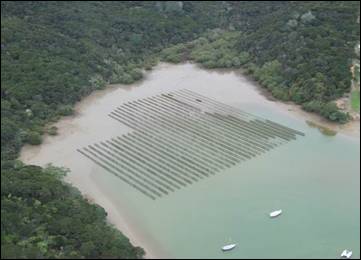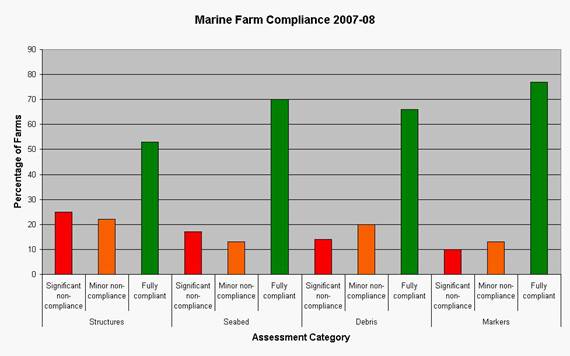Aquaculture Monitoring
Within this section…
NRC is responsible for the administration and monitoring of approximately 133 marine farm resource consents in Northland. The majority of these farms are oyster farms within the intertidal regions of Northland's estuaries and harbours. There are also 6 mussel farms at Houhora Bay and in the Kaipara harbour and 1 mussel spat-catching farm in Whangape harbour.

Photo: Oyster farm, Bay of Islands
Consented Monitoring
NRC undertakes visual inspections of all marine farms on a biannual basis, usually between March and May. These inspections involve assessing each farm for compliance with the conditions of resource consent. Each farm is assessed on the following criteria:
· The condition of the farm structures - including racks, bins, lines, buoys, etc;
· The condition of the seabed - the amount of shell and sediment deposition beneath the farming structures;
· Presence of debris - this includes any debris within the farm or surrounding area that originated from the farm; and
· Presence of navigational markers – including location and suitability of the markers to ensure the safety of other marine users.
Depending on the results of the assessment, each farm is given a compliance grade - fully compliant, minor non-compliance or significant non-compliance. The graph below summarises the results from the 2007-08 survey season.

Farms that were found to have minor non-compliance in any of the assessment categories were requested to undertake remedial action. Abatement notices were issued to 25 farmers with significant non-compliance, requiring them to undertake actions to ensure compliance by the next inspection in mid-2009.
Non Consented Monitoring
During the 2007-08 financial year, NRC commissioned the Cawthron Institute (using an Envirolink grant) to review literature on the ecological effects of intertidal oyster farms. The report was commissioned in order to gain a better understanding of the environmental impacts of oyster farming, which could be used to enable more effective management of the 130 oyster farms in the region.
The key finding of this report was that the largest potential ecological impact of oyster farming comes from the introduction and spread of pest organisms. The NRC biosecurity team is currently reviewing the Regional Pest Management Strategies, with a particular focus on marine pests, in order to mitigate this potential impact.
The second most significant ecological impact is on the seabed within and immediately adjacent to oyster farms. However, this impact appears to be reversible once farming ceases.
Historically, monitoring of oyster farms has focused on compliance with resource consents rather than the effects of the farm. The NRC coastal monitoring team is currently investigating an effects-based monitoring programme to assess seabed status in and around oyster farms in Northland. Proposed sites for study include the Hokianga and Houhora harbours.
